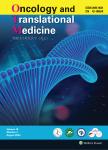Induction chemotherapy followed by weekly paclitaxel and carboplatin with concurrent radiotherapy in inoperable stage Ⅲ non-small cell lung cancers: results of a phase Ⅱ trial
不能手术的Ⅲ期非小细胞肺癌患者每周紫杉醇和卡铂并同步放疗的诱导化疗:一个Ⅱ期研究结果(英文)作者机构:Clinical Oncology and Nuclear Medicine DepartmentFaculty of MedicineMansoura University
出 版 物:《The Chinese-German Journal of Clinical Oncology》 (中德临床肿瘤学杂志(英文版))
年 卷 期:2013年第12卷第2期
页 面:56-60页
学科分类:1002[医学-临床医学] 100214[医学-肿瘤学] 10[医学]
主 题:induction chemotherapy non-small cell lung cancer (NSCLC) carboplatin paclitaxel concurrent radiotherapy
摘 要:Objective: several trials have suggested the superiority of concurrent chemoradiotherapy. It has been hypothesized that the addition of systemic dose sequential chemotherapy to concurrent chemoradiotherapy, as induction or as consolidation, might further improve survival rates. So we sought to evaluate the safety and efficacy of induction paclitaxel and carboplatin followed by weekly paclitaxel and carboplatin with concurrent radiotherapy in inoperable stage III non-small cell lung cancer (NSCLC). Methods: Fifty-six patients with stage III inoperable NSCLC received induction chemotherapy with 2 cycles of paclitaxel 200 mg/m2 and carboplatin AUC-6 every 3 weeks then patients were assigned to concurrent chemoradiotherapy with paclitaxel 45 mg/m2 and carboplatin AUC-2 weekly along with concurrent radiotherapy at dose of 60 Gy (1.8 Gy/d x 5 d/week). Results: Median age of the 56 eligible patients was 61 years, most of them were males (87.5%). Squamous cell carcinoma was the most common pathological type (55.4%) and 85.7% had a performance status of 1. The majority of patients were presented with stage IIIB (62.5%). Neutropenia was the most common toxicity during induction therapy (12.5% expressed grade 3) whereas esophagitis was the most common non hematologic adverse reaction during concurrent chemoradiotherapy (14.3% of grade 3). The overall response rate was 71.6% with complete response in 19.6%. After median follow up of 20 months, the median survival time was 13 months (95% CI: 10.917-15.083) and 1 year overall survival rate was 53.6%. Conclusion: This regimen has demonstrated an acceptable toxicity profile and encouraging response to treatment. Evaluation of this regimen in larger number and a phase III trial are recommended.



